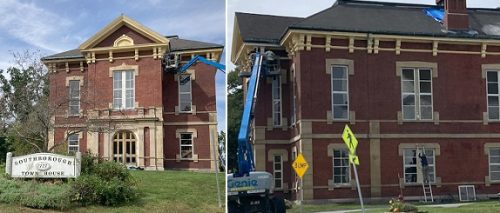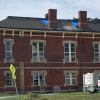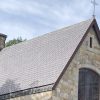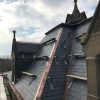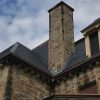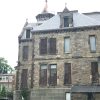Above: Restoration work in process on the exterior of the Town House will include more historic detail than originally presented to voters — though still within the approved budget. (photos by Beth Melo)
The project voters approved to preserve and restore the Town House is getting an upgrade. While still within the budget, it will now include two elements that weren’t originally planned — restoring historic windows and replacing the asphalt roof with more historically accurate slate tiles.
One outvoted Select Board member strongly disagreed with with the justification of investing Community Preservation Act (CPA) funds in a slate roof to provide savings for future taxpayers. As a result of their debate, the board may create a policy to determine how projected savings are calculated in the future.
At a special July 28th meeting, the board debated both the financials and the merits of the decision. In a 4-1 vote, the board approved the decision (contingent on a condition just met last week). Dissenting member Al Hamilton criticized the vote in a subsequent meeting. He called for the board to hash out an agreement on “Present Value Calculations” for future financial decisions.
Below are my recaps of the coming improvements, the board’s debate, and their plans to proceed.
Town House Improvement Decisions
For years, the Town pushed off Facilities’ requests for maintenance improvements, especially new windows, on Town House built in 1870 which serves as Town Hall and the office building for several Town departments.
In 2021, the Select Board agreed to bundle maintenance needs with a Historic Restoration and Preservation project. It was pitched as a financially savvy way to tap into CPA funds and avoid increasing taxes to cover maintenance. (CPA funds come out of a separate bucket and include a partial match from the state. You can read more about the Town’s CPA match status and potential changes here.)
At Town Meeting, voters approved dedicating $2,238,283 in CPA funds to the project, including a $251,340 for unforeseen costs. (You can view the details pitched and projected budget in the Town’s handout here.)
Since then, Facilities found that costs were different than initially projected, motivating Director John Parent to request change orders that he believed better met the project needs. Even with those changes, Parent expects the project to be within budget (without touching the contingency fees).
Historic Window Restoration
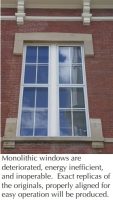 The project detailed in a handout at Town Meeting explained that the current “energy inefficient, and inoperable” windows would be replaced by modern replicas that could open and close.
The project detailed in a handout at Town Meeting explained that the current “energy inefficient, and inoperable” windows would be replaced by modern replicas that could open and close.
In December 2022, the Town’s contractor told the Community Preservation Committee that the replacement windows turned out be double the projected expense. Fortunately, the architect explained that for a lower cost the current windows could be restored with full functionality. For energy efficiency, they would use low profile storm windows (like those installed at the Library) that could also be replaced with screen panels.
You can read the full explanation their minutes.
Asphalt vs Slate Roof
This summer, the CPC approved Parent’s new request for a slate roof. This time, the change was also brough to the Capital Improvement & Planning Committee (CIPC) for a recommendation to the Select Board. At a morning meeting on July 28th, the board reviewed the request and CIPC’s findings.
Parent told the board that supply pipelines had improved and other project costs were coming in lower than expected. He looked into the cost and determined that spending the additional $230K to install a slate roof instead of asphalt would make long term sense while improving the historical restoration.
Parent asserted a slate roof would be good for at least 90 years and maybe well beyond. He repeatedly referred to the over 150 year old roof of the abutting St. Mark’s Church. He noted that asphalt roofs need to be replaced at least every 30 years.
He also pitched to members the beauty of the St. Mark’s Church slate roof vs the asphalt on the Town House and Pilgrim Church. (See my photos below.)
Since the tiles on St. Mark’s Church are distinctively shaped, I reached out to Parent to find out what the slate on the Town House roof would look like. He shared the below photos from similar projects as examples:
As for the financials, Hamilton argued that that the Town House isn’t a museum, “it is a place of business”. He noted that no one has been complaining that the building has an asphalt roof. He argued that the investment didn’t make financial sense. Repeating a complaint he has made often, Hamilton said too much money is spent on that small section of town.
Select Board members Kathy Cook and Sam Stivers projected that using the slate would provide savings. They compared the figures to replacing the roof in 30, 60, and 90 years, and included an inflation multiplier. In contrast Hamilton calculated that the slate would be more expensive than replacing the roof in 30 and 60 years. He acknowledged that he didn’t calculate inflation, but didn’t believe the difference would be significant enough to change his mind.
Hamilton argued residents could pay for a new asphalt roof in 30 years. He wasn’t swayed by the long term savings, noting he’d be dead by then.
Member Marguerite Landry asked about the potentially more expensive maintenance costs for asphalt. Parent said that repairs shouldn’t be needed for some time and shouldn’t be a big issue when they are. He highlighted that more durable nails are used than in the past.
Landry referred to her own personal experience. She grew up with a slate roof and it was fine. In her past 30 years in Southborough, she had to replace her asphalt roof twice.
Chair Andrew Dennington believed the request went beyond just dollars and cents. He put it in context that the project was for improvements to the building envelope including aesthetics.
Following a recommendation by the CIPC, the change was contingent on structural engineers confirming that the building would be able to handle the additional weight.
I have been following up with Parent on the status of the engineers report, which took some time to be conducted. On Friday, he informed me that he got the positive report he needed. The Town will be proceeding with the installation.
You can read Parent’s request memo here.
Financial Calculus
At their regular August 8th meeting, Hamilton called the July 28th vote as “among the worst financial decisions we have ever made”. He said that it came down to a disagreement in how the board looks at present value calculations.
Hamilton said he discussed with Stivers how he did his calculations. They used “a very different set of assumptions”. He quipped that Stivers were ones “guaranteed to make the roof look good”. Stivers rebutted, “As opposed to yours which are designed to make it look bad.”
Hamilton said he believed the board needs to come to an understanding on the rates they use. He suggested that a discussion be held in open meeting with the Finance team, CIPC, and the Advisory Committee.
Cook agreed that it was a good idea. She noted that she had tried to discuss PV (Present Value) computations in the past, but the audience hadn’t been receptive.
The item hasn’t been on agenda since (and it’s not on their agenda posted for this Tuesday). But I’d expect it to be revisited this budget season.

